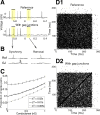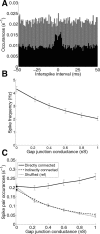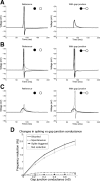Gap junctions between striatal fast-spiking interneurons regulate spiking activity and synchronization as a function of cortical activity
- PMID: 19386924
- PMCID: PMC2744332
- DOI: 10.1523/JNEUROSCI.6031-08.2009
Gap junctions between striatal fast-spiking interneurons regulate spiking activity and synchronization as a function of cortical activity
Abstract
Striatal fast-spiking (FS) interneurons are interconnected by gap junctions into sparsely connected networks. As demonstrated for cortical FS interneurons, these gap junctions in the striatum may cause synchronized spiking, which would increase the influence that FS neurons have on spiking by the striatal medium spiny (MS) neurons. Dysfunction of the basal ganglia is characterized by changes in synchrony or periodicity, thus gap junctions between FS interneurons may modulate synchrony and thereby influence behavior such as reward learning and motor control. To explore the roles of gap junctions on activity and spike synchronization in a striatal FS population, we built a network model of FS interneurons. Each FS connects to 30-40% of its neighbors, as found experimentally, and each FS interneuron in the network is activated by simulated corticostriatal synaptic inputs. Our simulations show that the proportion of synchronous spikes in FS networks with gap junctions increases with increased conductance of the electrical synapse; however, the synchronization effects are moderate for experimentally estimated conductances. Instead, the main tendency is that the presence of gap junctions reduces the total number of spikes generated in response to synaptic inputs in the network. The reduction in spike firing is due to shunting through the gap junctions; which is minimized or absent when the neurons receive coincident inputs. Together these findings suggest that a population of electrically coupled FS interneurons may function collectively as input detectors that are especially sensitive to synchronized synaptic inputs received from the cortex.
Figures







Similar articles
-
Effect of gap junctions on the firing patterns and synchrony for different external inputs in the striatal fast-spiking neuron network.Biomed Mater Eng. 2014;24(6):2635-44. doi: 10.3233/BME-141080. Biomed Mater Eng. 2014. PMID: 25226967
-
Cortical control of striatal fast-spiking interneuron synchrony.J Physiol. 2022 May;600(9):2189-2202. doi: 10.1113/JP282850. Epub 2022 Apr 11. J Physiol. 2022. PMID: 35332539 Free PMC article.
-
Synaptic Mechanisms of Tight Spike Synchrony at Gamma Frequency in Cerebral Cortex.J Neurosci. 2015 Jul 15;35(28):10236-51. doi: 10.1523/JNEUROSCI.0828-15.2015. J Neurosci. 2015. PMID: 26180200 Free PMC article.
-
Excitatory extrinsic afferents to striatal interneurons and interactions with striatal microcircuitry.Eur J Neurosci. 2019 Mar;49(5):593-603. doi: 10.1111/ejn.13881. Epub 2018 Mar 25. Eur J Neurosci. 2019. PMID: 29480942 Free PMC article. Review.
-
Connexon connexions in the thalamocortical system.Prog Brain Res. 2005;149:41-57. doi: 10.1016/S0079-6123(05)49004-4. Prog Brain Res. 2005. PMID: 16226575 Review.
Cited by
-
Significance and Translational Value of High-Frequency Cortico-Basal Ganglia Oscillations in Parkinson's Disease.J Parkinsons Dis. 2019;9(1):183-196. doi: 10.3233/JPD-181480. J Parkinsons Dis. 2019. PMID: 30594935 Free PMC article.
-
Parvalbumin Interneurons Modulate Striatal Output and Enhance Performance during Associative Learning.Neuron. 2017 Mar 22;93(6):1451-1463.e4. doi: 10.1016/j.neuron.2017.02.033. Neuron. 2017. PMID: 28334608 Free PMC article.
-
Endocannabinoid Release Modulates Electrical Coupling between CCK Cells Connected via Chemical and Electrical Synapses in CA1.Front Neural Circuits. 2011 Nov 22;5:17. doi: 10.3389/fncir.2011.00017. eCollection 2011. Front Neural Circuits. 2011. PMID: 22125513 Free PMC article.
-
Functional Properties of Dendritic Gap Junctions in Cerebellar Golgi Cells.Neuron. 2016 Jun 1;90(5):1043-56. doi: 10.1016/j.neuron.2016.03.029. Epub 2016 Apr 28. Neuron. 2016. PMID: 27133465 Free PMC article.
-
From Neuron Biophysics to Orientation Selectivity in Electrically Coupled Networks of Neocortical L2/3 Large Basket Cells.Cereb Cortex. 2016 Aug;26(8):3655-3668. doi: 10.1093/cercor/bhw166. Epub 2016 Jun 9. Cereb Cortex. 2016. PMID: 27288316 Free PMC article.
References
-
- Aertsen AMHJ, Gerstein GL, Habib MK, Palm G. Dynamics of neuronal firing correlation: modulation of “effective connectivity.”. J Neurophysiol. 1989;61:900–917. - PubMed
-
- Bar-Gad I, Morris G, Bergman H. Information processing, dimensionality reduction and reinforcement learning in the basal ganglia. Prog Neurobiol. 2003;71:439–473. - PubMed
-
- Bennett BD, Bolam JP. Synaptic input and output of parvalbumin-immunoreactive neurons in the neostriatum of the rat. Neuroscience. 1994;62:707–719. - PubMed
Publication types
MeSH terms
Grants and funding
LinkOut - more resources
Full Text Sources
Molecular Biology Databases
Research Materials
Miscellaneous
